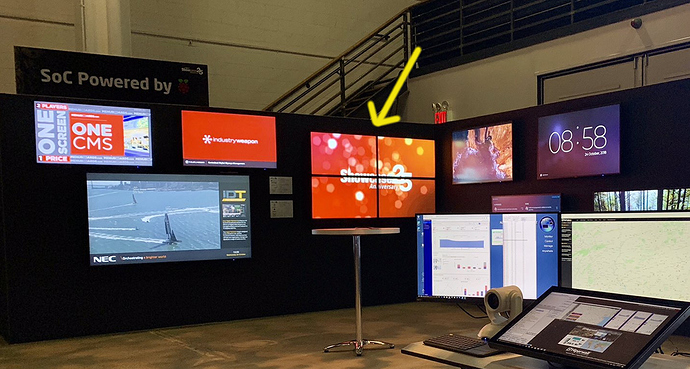info-beamer hosted is running a demo setup at the NEC New York Showcase. It’s a 2x2 video wall setup running a package that is (as of now) not yet publicly available. It’s the four NEC P404 SoC screens visible in the center of this photo by rAVe:
Unique feature: 4K (and more!) content
The Pi itself is limited to FullHD on a single screen, but it’s no problem across multiple screens. It’s also not limited to 4K. It can be scaled up to any resolution. So 8K or 16K across 16 or 256 displays are possible as well.
Videos are pre-split into individual parts and the running package automatically uses the correct one when assigning the video to the playlist. You can see the configuration interface for that package here:
Unique feature: Easy video wall assignment
This package is intended to be installed on various predefined video wall arrangement that are reused for multiple installations. So it wouldn’t make sense to manually adjust parameters for each video wall on its own. Instead there is a predefined list of templates (like the 2x2 Video Wall below). Screens can be assigned to them by selecting them from a dropdown:
Unique feature: dynamic content across multiple displays
Showing dynamic content on info-beamer style video walls is tricky as all four devices render their own output. By default there is no shared state. If you have dynamic content this gets complicated: Each devices fetches dynamic content from a remote service, it’s not guaranteed that they all get the same response. In the worst case this might result in all 4 screens showing different versions of the dynamic content. So if you show the image of some retail product, it might happen that the top monitor shows a half of a chair, while the bottom part shows half of a table. Clearly not what’s intended.
This package solves this by having an automated synchronization mechanism built-in that syncs state across multiple Pis. They detect each other automatically and each video wall forms its own group. One of the 4 devices is automatically selected as a master Pi. This Pi can fetch dynamic content from any source. It can then publish this content and a two-phase commit protocol makes sure that new content reaches either all Pis or none of them. Never only half of them.
In the example installation this feature is used to fetch information of random products from an API and present the product on all screens of the video wall.


